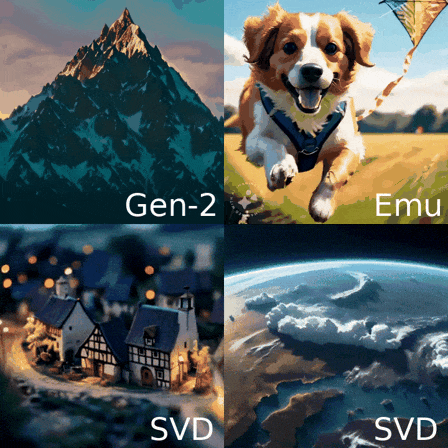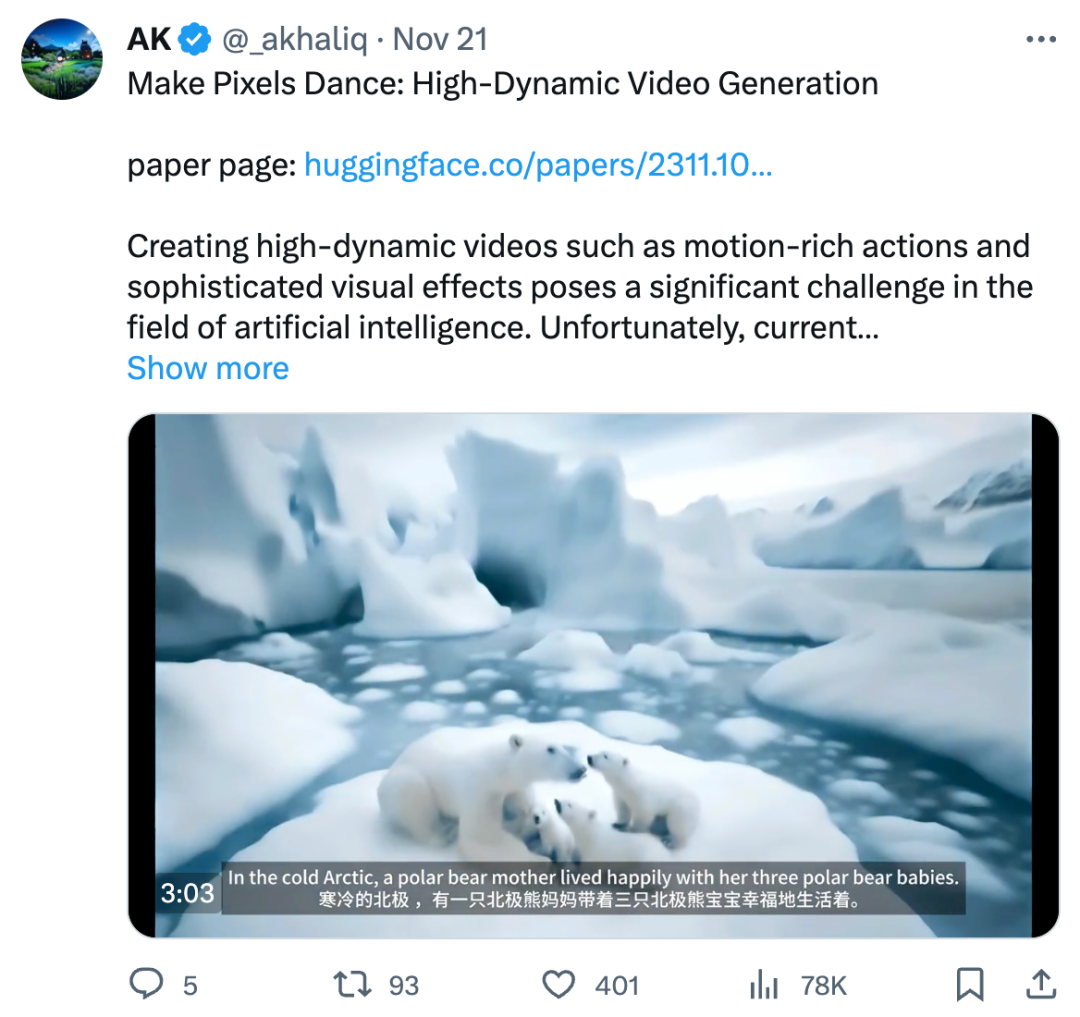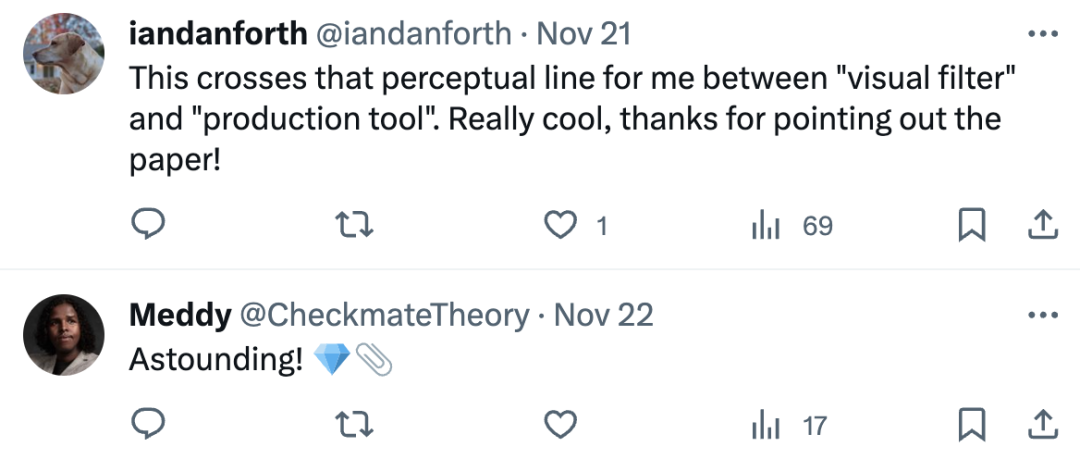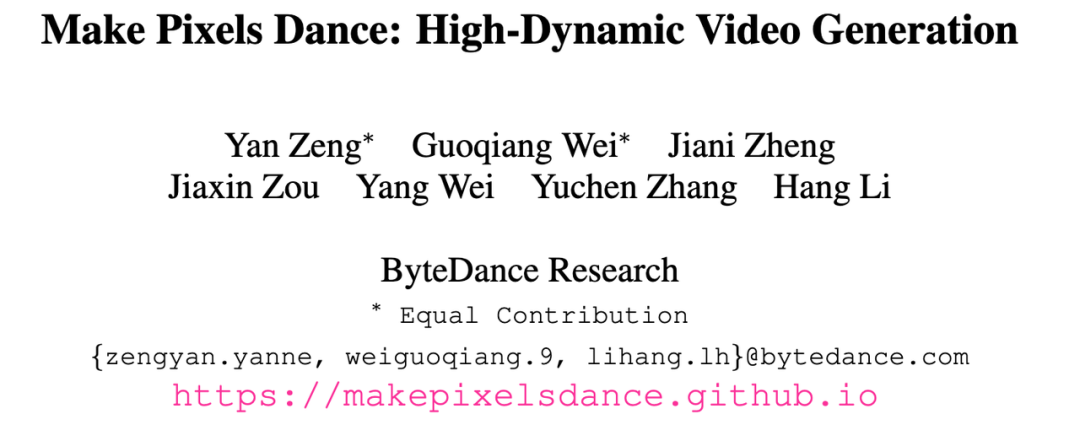 Technology peripherals
Technology peripherals
 AI
AI
 A new breakthrough in video generation: PixelDance, easily presenting complex movements and cool special effects
A new breakthrough in video generation: PixelDance, easily presenting complex movements and cool special effects
A new breakthrough in video generation: PixelDance, easily presenting complex movements and cool special effects
Recently, in addition to the widely watched large-scale language models that continue to occupy the headlines, video generation technology has also continued to make major breakthroughs, and many companies have successively released new models
First of all, Runway, as one of the earliest leaders to explore the field of video generation, has upgraded its Gen-2 model, bringing film-level high definition that is eye-catching. At the same time, the consistency of video generation has also been significantly improved
However, this improvement in consistency seems to come at the expense of video dynamics. It can be seen from the official promotional video of Gen-2 that although multiple short clips are assembled, the dynamics of each clip are relatively weak, making it difficult to capture clear actions and movements of characters, animals or objects.
Recently, Meta also released the video generation model Emu Video. As can be seen from Emu Video's official examples, the dynamics of its videos are significantly improved compared to Gen-2, but they are still limited to simpler actions.

Stability.ai, the company that developed the classic Vincent graph model Stable Diffusion, also recently released the open source video generation model Stable Video Diffusion ( SVD), which has attracted a lot of attention and discussion in the open source community. The effect of SVD is comparable to that of Gen-2. From the test sample, it can be seen that the video generated by SVD is relatively lacking in dynamics.

In the SVD paper, it was pointed out that the current video generated by SVD has insufficient dynamics
The above examples show that generating videos with high consistency and rich dynamics, so that the video content can truly move, is currently the biggest challenge in the field of video generation.
In this regard, the latest research results PixelDance have taken a critical step, and the dynamics of the generated results are significantly better than other existing models. , attracted the attention of the industry.

The PixelDance news forwarded by @_akhaliq, a well-known AI blogger on Twitter, has received nearly 80,000 views



On the official website (https://makepixelsdance.github.io), PixelDance gives Two different video generation modes.
There are two modes to choose from, the first is Basic Mode. In this mode, users only need to provide a guiding image and text description, and PixelDance can generate a highly consistent and dynamic video. The guidance picture can be a real photo, or it can be generated by the existing text generation model
From the results displayed, real style, animation style, two-dimensional style, PixelDance can handle all magical styles, including character movements, facial expressions, camera perspective control, and special effects movements. PixelDance can also complete them well. All I can say is tql!

The second is the advanced Magic Mode, which gives users more room to use their imagination and creativity. In this mode, users need to provide two guidance pictures and text descriptions, which can better generate more difficult video content. The website shows various cool special effects shots made with magic mode.

In addition, the official website also shows a 3-minute short story film entirely produced using PixelDance
What is very shocking is that using PixelDance can make the music as the user expected. A story, crafting every scene and corresponding action. Whether it is a real scene (such as Egypt, the Great Wall, etc.) or an imaginary scene (such as an alien planet), PixelDance can generate videos with rich details and action, even various special effects shots.
The protagonist Mr. Polar Bear’s black top hat and red bow tie are well maintained in various scenes. Now generating long videos is no longer a matter of simply piecing together irrelevant short video clips!
To achieve such outstanding video generation effects, it does not rely on complex data sets and large-scale model training. PixelDance only uses 1.5B on the public WebVid-10M data set. Small and large models achieve the above effects.

Paper address: https://arxiv.org/abs/2311.10982
Rewrite the content , without changing the original meaning, rewritten into Chinese: Please visit the following website to get the demo: https://makepixelsdance.github.io
In the corresponding paper "Make Pixels Dance: High-Dynamic Video Generation", the author pointed out the reason why video generation is difficult to achieve good results: compared with image generation, video generation has the characteristics of a significantly larger feature space and significantly greater action diversity. This makes it difficult for existing video generation methods to learn effective time-domain action information. Although the generated videos have high picture quality, their dynamics are very limited.
In response to the above problems, PixelDance proposes a video generation method based on text guidance and first and last frame picture guidance, so that the model can more fully pay attention to and learn the dynamic information of the video.
In video generation, the first frame of the picture provides the framework and material for the entire video content. At the same time, longer videos can be generated by using the last frame of the previous video clip as a guide for the first frame of the next clip. The video text description describes the specific content of the video action. The last frame picture guidance provides end status information for the video generation process. The author proposes an adaptation method that enables the model to accept relatively rough images as guidance, which allows users to use basic image editing tools to obtain end frame image guidance
official website The information shows that it is still actively iterating the model effect, and a model that everyone can try will be released in the next 2-3 months. At present, the author also provides a way to support everyone in sending samples they want to test. Currently, some user test samples have been released on the official website:

It seems that with PixelDance, everyone can become a "million-dollar special effects master" as long as they have a wild imagination!
The above is the detailed content of A new breakthrough in video generation: PixelDance, easily presenting complex movements and cool special effects. For more information, please follow other related articles on the PHP Chinese website!

Hot AI Tools

Undresser.AI Undress
AI-powered app for creating realistic nude photos

AI Clothes Remover
Online AI tool for removing clothes from photos.

Undress AI Tool
Undress images for free

Clothoff.io
AI clothes remover

Video Face Swap
Swap faces in any video effortlessly with our completely free AI face swap tool!

Hot Article

Hot Tools

Notepad++7.3.1
Easy-to-use and free code editor

SublimeText3 Chinese version
Chinese version, very easy to use

Zend Studio 13.0.1
Powerful PHP integrated development environment

Dreamweaver CS6
Visual web development tools

SublimeText3 Mac version
God-level code editing software (SublimeText3)

Hot Topics
 1386
1386
 52
52
 How to solve SQL parsing problem? Use greenlion/php-sql-parser!
Apr 17, 2025 pm 09:15 PM
How to solve SQL parsing problem? Use greenlion/php-sql-parser!
Apr 17, 2025 pm 09:15 PM
When developing a project that requires parsing SQL statements, I encountered a tricky problem: how to efficiently parse MySQL's SQL statements and extract the key information. After trying many methods, I found that the greenlion/php-sql-parser library can perfectly solve my needs.
 How to solve the complexity of WordPress installation and update using Composer
Apr 17, 2025 pm 10:54 PM
How to solve the complexity of WordPress installation and update using Composer
Apr 17, 2025 pm 10:54 PM
When managing WordPress websites, you often encounter complex operations such as installation, update, and multi-site conversion. These operations are not only time-consuming, but also prone to errors, causing the website to be paralyzed. Combining the WP-CLI core command with Composer can greatly simplify these tasks, improve efficiency and reliability. This article will introduce how to use Composer to solve these problems and improve the convenience of WordPress management.
 How to solve complex BelongsToThrough relationship problem in Laravel? Use Composer!
Apr 17, 2025 pm 09:54 PM
How to solve complex BelongsToThrough relationship problem in Laravel? Use Composer!
Apr 17, 2025 pm 09:54 PM
In Laravel development, dealing with complex model relationships has always been a challenge, especially when it comes to multi-level BelongsToThrough relationships. Recently, I encountered this problem in a project dealing with a multi-level model relationship, where traditional HasManyThrough relationships fail to meet the needs, resulting in data queries becoming complex and inefficient. After some exploration, I found the library staudenmeir/belongs-to-through, which easily installed and solved my troubles through Composer.
 How to solve the complex problem of PHP geodata processing? Use Composer and GeoPHP!
Apr 17, 2025 pm 08:30 PM
How to solve the complex problem of PHP geodata processing? Use Composer and GeoPHP!
Apr 17, 2025 pm 08:30 PM
When developing a Geographic Information System (GIS), I encountered a difficult problem: how to efficiently handle various geographic data formats such as WKT, WKB, GeoJSON, etc. in PHP. I've tried multiple methods, but none of them can effectively solve the conversion and operational issues between these formats. Finally, I found the GeoPHP library, which easily integrates through Composer, and it completely solved my troubles.
 How to solve the problem of PHP project code coverage reporting? Using php-coveralls is OK!
Apr 17, 2025 pm 08:03 PM
How to solve the problem of PHP project code coverage reporting? Using php-coveralls is OK!
Apr 17, 2025 pm 08:03 PM
When developing PHP projects, ensuring code coverage is an important part of ensuring code quality. However, when I was using TravisCI for continuous integration, I encountered a problem: the test coverage report was not uploaded to the Coveralls platform, resulting in the inability to monitor and improve code coverage. After some exploration, I found the tool php-coveralls, which not only solved my problem, but also greatly simplified the configuration process.
 git software installation tutorial
Apr 17, 2025 pm 12:06 PM
git software installation tutorial
Apr 17, 2025 pm 12:06 PM
Git Software Installation Guide: Visit the official Git website to download the installer for Windows, MacOS, or Linux. Run the installer and follow the prompts. Configure Git: Set username, email, and select a text editor. For Windows users, configure the Git Bash environment.
 How to solve the problem of virtual columns in Laravel model? Use stancl/virtualcolumn!
Apr 17, 2025 pm 09:48 PM
How to solve the problem of virtual columns in Laravel model? Use stancl/virtualcolumn!
Apr 17, 2025 pm 09:48 PM
During Laravel development, it is often necessary to add virtual columns to the model to handle complex data logic. However, adding virtual columns directly into the model can lead to complexity of database migration and maintenance. After I encountered this problem in my project, I successfully solved this problem by using the stancl/virtualcolumn library. This library not only simplifies the management of virtual columns, but also improves the maintainability and efficiency of the code.
 Solve CSS prefix problem using Composer: Practice of padaliyajay/php-autoprefixer library
Apr 17, 2025 pm 11:27 PM
Solve CSS prefix problem using Composer: Practice of padaliyajay/php-autoprefixer library
Apr 17, 2025 pm 11:27 PM
I'm having a tricky problem when developing a front-end project: I need to manually add a browser prefix to the CSS properties to ensure compatibility. This is not only time consuming, but also error-prone. After some exploration, I discovered the padaliyajay/php-autoprefixer library, which easily solved my troubles with Composer.



